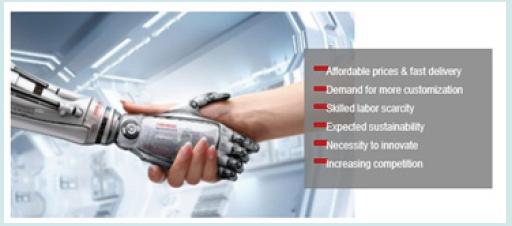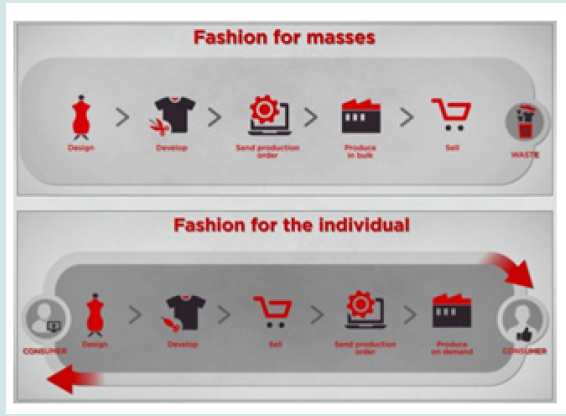
Lupine Publishers Group
Lupine Publishers
Menu
ISSN: 2637-4595
Review Article(ISSN: 2637-4595) 
4.0 Industrial Revolution in Clothing Production Volume 5 - Issue 4
Vasilije Petrovic1*, Dragan Djordjic2, Anita Milosavljevic1, Marija Petrovic2 and Jelena Djukic3
- 1University of Novi Sad, Technical faculty “Mihajlo Pupin”, Serbia
- 2University of Travnik, Faculty of Technical Studies, Serbia
- 3Pirin Tex, German Textile Company, Goce Delchev, Bulgaria
Received:February 13, 2023 Published: March 03, 2023
*Corresponding author: Vasilije Petrovic, University of Novi Sad, Technical faculty “Mihajlo Pupin”, Serbia
DOI: 10.32474/LTTFD.2023.05.000216
Abstract
I the paper it is defined that the 4.0 Industrial Revolution is the digitization and interconnection of every machine in the company, every technological component and practically every piece of material that goes through the manufacturing process of garment manufacturing. The needs of investing in research and development, work education - to make the vision of a smart textile factory a reality was discussed. A “smart factory” is explained, which allows links between innovation subject, universities and other educational institutions, industry in the areas of procurement and distribution, as well as state administration and banks. There are 4 key innovative topics highlighted that will shape the textile and apparel industries of the future: advanced materials, digitalization, sustainability and emerging growth markets. The example of the French company Lectra explains the digital transformation of the clothing industry in strengthening brands and manufacturers from design to production. The influence of the generation of Millennials born in 1980-2000 on changes in the fashion market is explained. They make up 20-30% of the world’s population, can access the world from their own pocket, seek personal style, want instant results in production,…
Keywords: 4.0 industrial revolution; clothing production; millennials; personalization
Introduction
Industry 4.0 is a new concept of work organization in the industry and service sectors. This term was mentioned in Germany in 2011 by Deutsche Working Group. The aim of this concept promotion is reflected in the direction of investment in projects for industry modernization in the new conditions of widespread digitalization which is enabled by technique development. The main goal is adoption of new, modern work processes by developing techniques and products. Requirements are being made of necessary response to changing market demands, as well as aggressive and increasing competition [1-4].
4.0 Industrial Revolution
The European Technology Platform (ETF) for the future of textiles and clothing is the largest European network that is dedicated for research and innovation in textiles (bringing together 500 experts). This network gives the following definition: The industrial revolution 4.0 is digitalization and interconnection of every machine in the company , every technological component and every piece of material that goes through the production process [5]. The development of the 4.0 Industrial Revolution requires significant investments in research, development and work education so the vision of a smart textile factory could become a reality. The European Technology Platform defines four key innovative topics that will shape the textile and clothing industry of the future and those are: advanced materials, digitalization, sustainabillity, new growth markets [5].
Although it is expected that these events continue, additional powerful innovators will affect the future of this industry in the coming years. This includes the digitalisation of products, processes, factories, jobs, supply chains, distribution and retail. A key feature of the Industry 4.0 concept is [1-4]: Full digitalization, computer monitoring and management of production and business processes, mutual communication of M2M (Machine to Machine), H2M (Human to Machine) and M2H (Machine to Human). Enabling machines , devices, sensors and humans to connect and to communicate on relation Internet of things (IoT) or Internet of people (IoP). It is necessary to unify the machine language, because there are many protocols and transport media that makes almost impossible merging and sharing data about machine.
Concept of industry 4.0 is about a “smart factory” that uses information and communication technology for production managing and manufacturing processes within marketplace, achieving better quality , low cost and flexible manufacturing of custom products. For “smart factory” is used the name “learning factory”. This name is used because, in accordance with changes in the market, technology, science, available resources involved, the staff is continuously educated, and the company is immediately or quickly adapting to new conditions [7-8].
Intelligent production will lead to lower product prices, which will attract a large number of new customers in the market. In addition, intelligent production opens the possibilities for providing additional customer service. Special emphasis is placed on personal production. It is the possibility of individual production for a known customer, according to his requirements, which thus participate in the creation of the product. The virtual creation of the products makes a new form of communication with customers. This raises the possibility for involving the wishes of customers in the process of experimenting with new products and its design [3-4].
4.0 Industry Revolution - Application for Making Clothes
Nowadays, the automation of clothing production isn’t’t completely done, because in the industrial production of clothing, the participation of human labour in the final product is from 60- 70%. However, changes in the market show that, in addition to mass production, there is a growing demand for custom made industrial clothing. There is a personal production that wants to comply with the requirements of each individual customer. This opens a new business challenge for conversion of production lines from large series to mass production (Figure 1). Mass production refers to a large number of products of the same production process but different: dimensions (size numbers), cuts, patterns, etc. This is a solution that represents the application of ideas and principles of the clothing industry 4.0 [7,8]. An example, of today’s developed system from design to clothing production is partly automated and includes: automatic taking measures of the customer, automatic correction of cutting parts according to customer’s needs, virtual fashion show, model trying out, correction of identified deficiencies, partial automation of production and delivery to the customer of ready-made clothing product. The production models of companies Lectra (Figure 2), Shima Seiki (Figure 3) and a large number of companies form fashion sector can be mentioned as examples.
Figure 3: 3D system for design – APEKS that connects all manufacturing activities in the form of the large tree [9].

The digitalization of production for the conversion from mass production to individual (personal) production is offered by the French company Lectra. The difference in the production process between mass and individual production is shown in Figure 4. The thinking of large companies to change their production to personal production is due to the new generation of customers which uses the name Millennials. It is a generation born between 1980. and 2000. Millennials have access to product purchases that are very different from previous generations of customers. Figure 5 shows this generation. They make up 20-30% of the world’s population, can access the world from their own pocket, seek personal style, want instant results [10-14].
Conclusion
The 4.0 Industrial Revolution is represented by digitalization and interconnection of every machine in the company, every technological component and practically every piece of material that goes through the manufacturing process of clothing manufacturing. The goal of the 4.0 Industrial Revolution is reflected in vision to textile “smart factory” became a reality. The “smart factory” provides relationship between innovation entities, universities and other educational institutions, industry in the areas of procurement and distribution, training of personnel, as well as with government and banks. The four key innovative themes that will shape the textile and clothing industry of the future are: advanced materials, digitalization, sustainability and emerging growth markets. Of great importance is the training of personnel for the new jobs in the industrial revolution 4.0. In the case of French company Lectra the digital transformation of clothing industry is explained. The influence of the generation of millennials born between 1980-2000 on changes in the fashion market is explained. They make up 20- 30% of the world population, can access the world from their own pocket, they look for personal style, want instant results.
References
- Petrovic V (2019) Digitalization in the textile industry – 4.0 Industrial revolution in clothing production, International Joint Conference on Environmental and Light Industry Technologies, 7th International Joint Conference on Environmental and Light Industry Technologies, The Faculty of Light Industry and Environmental Engineering of Obuda University, 21-22, Budapest, Hungary, pp. 11-21.
- Petrovic V (2019) How digital is the Adriatic Textile Industry? Reality and Trends, International Conference Digital Fashion, Lectra Deutschland GmbH, Zagreb. pp. 42-52.
- https://futura-automation.com/2017/10/15/industry-4-0-will-manufacturers/
- https://www.tandfonline.com/doi/full/10.1080/00207543.2019.1652777
- http://www.textile-platform.eu
- https://www.lectra.com/en
- Nikolić G (2008) Industrija 4.0 i obrazovni sustav. Open Info Trend pp. 28-36.
- Nikolić G, Rogale D (2017) Industrija 4.0 - pravac razvoja tekstilne i odjevne industrije. Tekstil 66(3-4): 65-73.
- http://www.shimaseiki.co.jp
- https://pks.rs/
- Rogale D (2011) Procesi proizvodnje odjece, Tekstilno – tehnoloski fakultet, Univerziteta u Zagrebu.
- Petrovic V (2016) Modna kolekcija, Tehnicki fakultet “Mihajlo Pupin“, Zrenjanin.
- Ujević D (2010) Tehnike konstruiranja i modeliranja odjece, Tekstilno - tehnološki fakultet, Zrinski dd, Čakovec, Zagreb.
- Petrovic V (2013) Savremena kretanja u tekstilnoj i odevnoj industriji u Evropi, Menadzment, Inovacije, Razvoj 8 (1): 83-89.

Top Editors
-

Mark E Smith
Bio chemistry
University of Texas Medical Branch, USA -

Lawrence A Presley
Department of Criminal Justice
Liberty University, USA -

Thomas W Miller
Department of Psychiatry
University of Kentucky, USA -

Gjumrakch Aliev
Department of Medicine
Gally International Biomedical Research & Consulting LLC, USA -

Christopher Bryant
Department of Urbanisation and Agricultural
Montreal university, USA -

Robert William Frare
Oral & Maxillofacial Pathology
New York University, USA -

Rudolph Modesto Navari
Gastroenterology and Hepatology
University of Alabama, UK -

Andrew Hague
Department of Medicine
Universities of Bradford, UK -

George Gregory Buttigieg
Maltese College of Obstetrics and Gynaecology, Europe -

Chen-Hsiung Yeh
Oncology
Circulogene Theranostics, England -
.png)
Emilio Bucio-Carrillo
Radiation Chemistry
National University of Mexico, USA -
.jpg)
Casey J Grenier
Analytical Chemistry
Wentworth Institute of Technology, USA -
Hany Atalah
Minimally Invasive Surgery
Mercer University school of Medicine, USA -

Abu-Hussein Muhamad
Pediatric Dentistry
University of Athens , Greece

The annual scholar awards from Lupine Publishers honor a selected number Read More...








